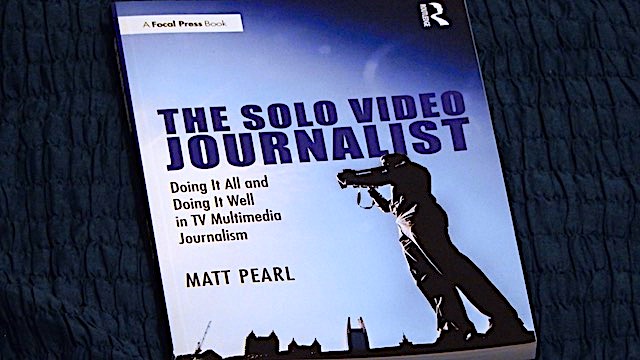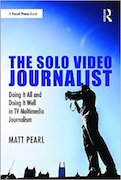I am a television news reporter for the NBC affiliate in Atlanta, Ga., the 10th largest TV market in the country. But I am also my own photographer, shooting and editing the video that becomes my pre-produced reports. From the start of my day to the finish, I am almost always on my own.
And I represent a growing reality in TV news.
The term “multimedia journalist” gets thrown around in the news business, but in television it has a clear meaning. It refers to a journalist who produces a report from start to finish, combining the jobs of a traditional reporter (researching, interviewing, writing) with those of a traditional photographer (shooting, editing). We now occupy a substantial part of TV newsrooms; per the latest survey, roughly nine of every ten local network affiliates use them in some capacity. When aspiring television journalists go to college, they are warned they will almost certainly start their careers – and likely spend a good chunk of them – as one-woman and one-man bands.
Yet no book exists that offers a comprehensive overview of what the job entails, with the insights and authorship of journalists working in the business.
So I wrote one.
I am proud and excited to announce the release of The Solo Video Journalist, available now on Amazon and Barnes & Noble. It is a how-to guide for a position in TV news that is long overdue for such analysis: the multimedia journalist, or MMJ.
(… or backpack journalist, or VJ, or any number of titles bestowed upon this position through the years. I went with “solo video journalist” because I think that term most accurately describes the job: producing video stories and journalism on one’s own.)
I have held this title since I entered the business more than a decade ago, and I have remained astounded at the lack of explicit instruction exists for those who do it. So many, both inside and outside the business, continue to envision newsrooms full of traditional reporters and photographers, neglecting the vital role MMJs have come to play.
The reality is far different.
Nearly every local newsroom in the country contains MMJs, and most mid- to small-market newsrooms rely on them. When I speak at conferences about the life of a solo video journalist, I always ask for a show of hands of who else holds this title. The majority of the audience — and virtually all of the younger journalists — raise their hands.
I have been fortunate to experience both tremendous opportunities and great successes as a solo video journalist, but I have always believed passionately in using my position to help others. I accept virtually every speaking invitation I receive, and I constantly advise MMJs who reach out to me via e-mail. This past year I even worked with fellow passionate journalist John Kirtley to put on the NPPA Southeast Storytelling Workshop, designed to engage and inspire an audience from across the country. I invest in these causes because I cherish and respect the power of journalism and storytelling, and I want to empower as many as I can to thrive in this field.
This book should go a long way.
Over the course of nearly 200 pages, I walk step-by-step through a typical day as an MMJ. Each chapter covers a foundation of storytelling, but I specifically focus on the unique challenges that come with being a one-person crew.
In this case, I actually have some help.
I interviewed some of the finest MMJs in the business to break down each step:
- Jon Shirek of WXIA-TV on preparation and time management
- Heidi Wigdahl of KARE-TV on dressing for the dual roles of the job
- Greg Bledsoe of KNSD-TV on developing a system for one’s gear
- Anne Herbst of KUSA-TV on shooting video and B-roll
- Mitch Pittman of KOMO-TV on shooting interviews
- Joe Little of KGTV on shooting stand-ups
- Ted Land of KING-TV on logging and writing
- Forrest Sanders of WSMV-TV on editing
- Mike McCarthy of WSYX-TV on working the web and social media
I have also included “break” chapters with additional interviews about the job. Mike Castellucci, formerly of WFAA-TV, discusses using smaller cameras. Peter Rosen of KSL-TV talks about getting into the solo life at an older age. The one and only Boyd Huppert of KARE-TV stops by to offer insights for any journalist, MMJ or otherwise.
Huppert also wrote the book’s foreword, and I am extraordinarily honored he agreed to do so.
The Solo Video Journalist can benefit any MMJ, but it is specifically aimed at those just starting in the business. I know how it feels to enter the industry and feel overwhelmed by the many responsibilities and obstacles that come with the solo life. I want today’s aspiring storytellers to feel far better equipped than I did. My publisher and I are working to encourage journalism professors to use this book in their classes. It is the rare book that covers an often overlooked position in modern television news — and is written by someone currently doing that job.
The secret is out … and I can’t wait to see what happens.
The Solo Video Journalist is available for purchase. You can find it on Amazon, Barnes & Noble, and the publisher’s web site.
Matt Pearl is the author of the Telling the Story blog and podcast. Feel free to comment below or e-mail Matt at matt@tellingthestoryblog.com. You can also follow Matt on Facebook and Twitter.


One thought on “Introducing “The Solo Video Journalist”, my how-to book for aspiring MMJs”